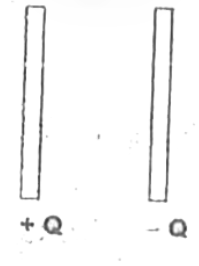In a parallel plate capacitor with plate area A and charge Q, the force on one plate because of the charge on the other is equal to
Q2ε0A2
Q22ε0A2
Q2ε0A
Q22ε0A
The correct Answer is:D
To find the force on one plate of a parallel plate capacitor due to the charge on the other plate, we can follow these steps:
1. Understand the Configuration:
A parallel plate capacitor consists of two plates, one positively charged (+Q) and the other negatively charged (-Q). The area of each plate is denoted as A.
2. Calculate the Electric Field (E):
The electric field (E) between the plates of a parallel plate capacitor can be calculated using the formula:
E=σϵ0
where σ is the surface charge density and ϵ0 is the permittivity of free space. The surface charge density σ is given by:
σ=QA
Therefore, the electric field becomes:
E=QAϵ0
3. Determine the Electric Field Due to One Plate:
Each plate creates an electric field. The electric field due to one plate (say the positively charged plate) is:
E1=Q2Aϵ0
The factor of 1/2 arises because each plate contributes half of the total electric field in the region between them.
4. Calculate the Force on One Plate:
The force (F) on one plate due to the electric field created by the other plate can be calculated using the formula:
F=qE
Here, q is the charge on the plate experiencing the force, and E is the electric field due to the other plate. For the negatively charged plate, the force will be:
F=Q⋅E1=Q⋅Q2Aϵ0
Simplifying this gives:
F=Q22Aϵ0
5. Final Result:
Thus, the force on one plate due to the charge on the other plate is:
F=Q22Aϵ0
A parallel plate capacitor consists of two plates, one positively charged (+Q) and the other negatively charged (-Q). The area of each plate is denoted as A.
The electric field (E) between the plates of a parallel plate capacitor can be calculated using the formula:
E=σϵ0
where σ is the surface charge density and ϵ0 is the permittivity of free space. The surface charge density σ is given by:
σ=QA
Therefore, the electric field becomes:
E=QAϵ0
Each plate creates an electric field. The electric field due to one plate (say the positively charged plate) is:
E1=Q2Aϵ0
The factor of 1/2 arises because each plate contributes half of the total electric field in the region between them.
The force (F) on one plate due to the electric field created by the other plate can be calculated using the formula:
F=qE
Here, q is the charge on the plate experiencing the force, and E is the electric field due to the other plate. For the negatively charged plate, the force will be:
F=Q⋅E1=Q⋅Q2Aϵ0
Simplifying this gives:
F=Q22Aϵ0
Thus, the force on one plate due to the charge on the other plate is:
F=Q22Aϵ0
Topper's Solved these Questions
- ELECTROSTATIC POTENTIAL AND CAPACITORSBOOK - DC PANDEY ENGLISHCHAPTER - ELECTROSTATIC POTENTIAL AND CAPACITORSEXERCISE - (B) Chapter exercises
17 Videos
- ELECTROMAGNETIC WAVESBOOK - DC PANDEY ENGLISHCHAPTER - ELECTROMAGNETIC WAVESEXERCISE - Sec C
22 Videos
- ELECTROSTATICSBOOK - DC PANDEY ENGLISHCHAPTER - ELECTROSTATICSEXERCISE - Medical entrances gallery
37 Videos
Similar Questions
Imagine a light planet revolving around a very massive star in a circular orbit of radius r with direction T. On what power of r, will the square of time period depends if the gravitational force of attraction between the planet and the star is proportional to r−5/2 .
View SolutionConsider a parallel plate capacitor having charge Q. Then,

View Solution
Knowledge Check
A parallel- plate capacitor with plate area A and separation between the plates d, is charged by a constant current i. Consider a plane surface of area A/2 parallel to the plates and drawn symmetrically between the plates. Find the displacement current through this area.
AIBI2CI4DI8
The capacitance of a parallel plate capacitor is 2μF and the charge on its positive plate is 2μC. If the charge on its plates is doubled, the capacitance of the capacitor
View SolutionA parallel plate capacitor is charged. If the plates are pulled apart
View SolutionA parallel plate capacitor of capacitance 3μF has total charge +15μC on one plate and total charge −15μC on the other plate. The separation between the plates is 1mm. The electric field between the plates has magnitude: (in N/C)
View SolutionA parallel- plate capacitor with plate area A and separation between the plates d, is charged by a constant current i. Consider a plane surface of area A/2 parallel to the plates and drawn summetrically between the plates. Find the displacement current through this area.
View SolutionA parallel- plate capacitor with plate area A and separation between the plates d, is charged by a constant current i. Consider a plane surface of area A/2 parallel to the plates and drawn summetrically between the plates. Find the displacement current through this area.
View SolutionIf the plates of a parallel plate capacitor are not equal in area, then
View SolutionA parallel plate capacitor is charged and then isolated. On increasing the plate separation
View Solution
